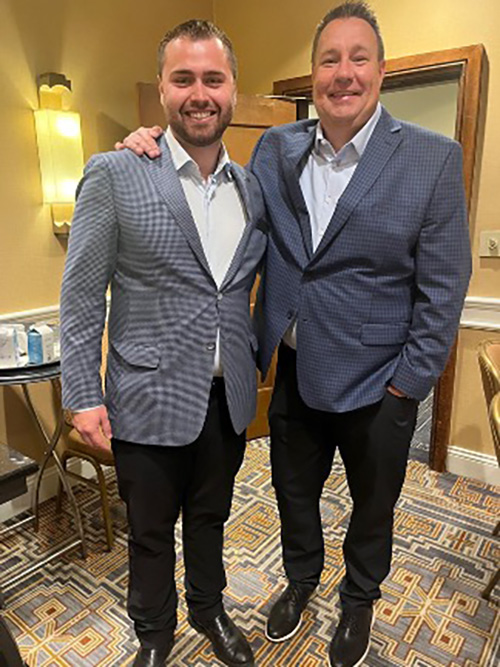I cannot tell you how many times in the nine years I’ve spent as a Business Guide since exiting my manufacturing business I’ve heard leaders, when asked to rate someone or something on a one to ten scale say, “I don’t give tens.”
Whenever I hear that, I follow the statement with a question that always has the same answer, “Why don’t you give tens?” So far, 100% of the time, the answer is either, “People can always do better,” or, “If I rate their performance a ten of ten, they’ll stop pushing themselves.”
While that answer may be understandable, it is also highly debatable. If a basketball player goes eight for eight from the free-throw line, could they have done better? Of course not. On a scale of one to ten, that’s a ten. But I get it. The premise behind the philosophy is based on the fear that if a leader gives a team member a ten out of ten when they deserve it, that team member will slack off and stop trying to improve.
Sadly, that mindset assumes the worst of people, and it also shows a lack of understanding of how the limbic system works in the human brain.
The Unintended Consequence of a “They Can Always Do Better” Mindset
I follow this by asking the leader if they think that over time, always telling people they could do better, even when those people exceeded expectations, will inspire those people to continue to go to battle for them and try harder and harder. Then I ask if there is a chance that they will eventually give up and stop trying so hard because they start to feel like their best is never going to be good enough. The leader almost always admits that the latter is much more likely to be the result.
Every once in a while, I will encounter a harsh leader who refuses to consider an alternative approach and insists on just being overly tough on everyone. In every single case I have observed, and I never know if it will happen in weeks or if will take as much as a year or more, that leader eventually leaves the organization. They either leave on their own because it becomes increasingly evident over time, as other leaders grow to embrace a more positive way to build a Culture of Performance, that they are just not a good fit, or they’re asked to leave because the owner sees the collateral damage being done by their leadership style and finally takes action.
The Science Behind Appreciation and the Limbic System
When people are constantly being ground on by their bosses to do better, their amygdala starts to send signals to the brain that trigger a fight or flight response, and as a result, neurochemicals like adrenaline and cortisol are released into the bloodstream. Depending on the extremity of the situation, this can actually cause the pre-frontal cortex (the part of the brain that controls our cognitive abilities) to begin to shut down. When that happens, it becomes harder on those affected to think clearly and make good decisions, which is the exact opposite of what the leader usually intends.
Conversely, when team members feel appreciated and have a healthy relationship with the leaders to whom they report, the opposite happens. Different neurochemicals, like oxytocin, serotonin and dopamine are released. This will often cause the team members to feel a sense of belonging and engagement, which enhances their commitment to the team and leader, and often their performance as well.
The SCARF Model
Dr. David Rock has done extensive work on this subject and has created what he calls the SCARF Model. This Model shows how as leaders, our behaviors and the way we interact with our teams, can cause our team members’ brains to respond in ways that they normally cannot control. It explains how the results of our interactions and leadership style often have a significant impact on our team members’ engagement and performance.
In a nutshell, SCARF is an acronym representing five areas that a leader can affect others in ways that cause nearly uncontrollable chemical reactions in the brain and ultimately impact the effectiveness of the people around them. At a very high level, you just need to understand that when people are in an environment where they experience a threat response, chemicals are released which affect their brain in ways that make it harder to think clearly. Our brains work in this way to protect us…to make us want to move away from the threat. Conversely, when they are in an environment where they feel rewarded, or appreciated, they experience a reward response. The reward response activates different chemicals in the brain and creates a desire to move toward, or engage more closely, with whatever caused them to experience the reward response.
SCARF Explained
The following is a brief summary of each component of the SCARF Model.
They key thing to remember as a leader, is that if your leadership style and disposition are consistently creating threat responses in your team members, you are likely undermining their ability to perform at a high level without even realizing it, actually working against your objectives as a leader. On the other hand, if you are intentional about affirming and appreciating all of the positive things your team members are doing, you will get all of the benefits resulting from the reward response. Of course, there are times where you have to be firm and direct, but it is important to always do so within the context of the SCARF Model. The more you focus on balancing correction and coaching with appreciation, the more trust you will build with others, which makes difficult conversations easier and more effective when they do have to happen.
- Status: If a leader berates an employee, especially in public, that action diminishes the team member’s status and can make them think less of themselves, which causes a threat response. It actually makes it more difficult to think clearly, which has a negative impact on performance. When a leader shows appreciation for positive performance or behaviors, team members will experience a reward response. As humans, we want more of that, and more often than not, people will adjust behaviors and actions to do more of the things that led to the appreciation and created the reward response.
- Certainty: If a leader creates an environment of uncertainty, like constantly making people feel that their job is on the line and they could be terminated at any time, it creates a threat response. The fear team members are constantly facing negatively impacts their performance because the constant fight or flight mode reduces the functionality of their prefrontal cortex. If, on the other hand, leaders establish clear expectations, coach team members where they need it, and help those team members feel that the leader has their backs and is supportive, they will have a sense of certainty, of security, and experience a reward response.
- Autonomy: When a leader is constantly micro-managing a team member, that team member will often lose any sense of autonomy in their role, and the result is a threat response. Nobody likes to be micromanaged, and it often is something we perceive as a threat. But when a leader, again with clearly communicated expectations, allows team members the freedom to make decisions on their own and have a reasonable degree of autonomy in their roles, that sense of autonomy causes them to experience a reward response.
- Relatedness: Human beings are “small group” animals. Most people do not like being in large crowds for extended periods of time, and also don’t like extended periods of isolation. When the environment at work pits people against one another in other to drive performance, they often feel isolated and alone at work. That results in a threat response. When people work in an environment with others who share common values and work together as a healthy team, even though most of us have some level of a competitive spirit, the clear common goals, under the guidance of healthy leadership, allow people to experience a reward response.
- Fairness: Lastly, when team members experience a lack of fairness, whether they are the target or they observe someone else being treated unfairly, they will almost always experience a threat response. Conversely, when people feel that they work in an environment where they know that people are treated fairly, they experience a reward response, especially in challenging situations where fairness is put to the test.
You can download a one-page overview of the SCARF Model using the link below.
A Personal Story of an Organization That Gets It Right
At Next Level Growth, we work with our clients to build elite organizations…organizations on a path to being a “category of one” in their market. We do this by teaching them a principled approach known as the Five Obsessions of Elite Organizations®. The fourth of the Five Obsessions is a Culture of Performance.
Oftentimes, when I bring up the necessity of a Culture of Performance in order to truly build something elite, people initially think about a hard-driving culture that grinds on team members, much like the Jack Welch style at GE during his tenure as CEO, where he famously fired the bottom 10% of the workforce every year. In my belief, that kind of a fear-based performance culture not only isn’t necessary, but it also rarely works in the long run.
My youngest son, Zachary, started working at the Fairmont Scottsdale Princess resort as a temporary employee during their Christmas at the Princess event. When the event concluded, Zachary was brought over as a full-time employee and began working as an Experience Concierge in their exclusive Privado Villas division.
If you’ve experienced the Fairmont brand, and if you’ve been fortunate to have experienced the Scottsdale Princess, you will know that the brand has a very high standard for guest experience, and in order to protect and consistently provide that, they have a very high bar when it comes to the behaviors and performance of their team members. What has been so refreshing to see is the way they build a high-performing culture through intentional signs of appreciation and personal connection with their team members.
If you are a parent of adult children, you will understand me when I say that when your adult children work for a bad boss, you get to hear all of the complaints and horror stories. My wife and I have heard plenty of those over the years that we’ve had adult children. On the other hand, when you hear your adult children consistently talking about how wonderful their managers and bosses are, and how appreciated they feel not only by those they directly report to, but also but the organization as a whole, you feel a peace knowing that they are in a good place to grow and develop.
David Miller is the Hotel Manager at the Fairmont Scottsdale Princess, and Jack Miller (no relation to David) is the Regional Vice President. While Zachary is far removed from them in the organizational structure, every time Zachary sees either of them on property, they go out of their way to say hello and be friendly to him. Not just him, but everyone. At a recent training meeting in advance of opening their new Privado Welcome Center, David Miller noticed that he and Zachary were weary nearly identical sportscoats, so he grabbed Zachary and had one of their colleagues take a photo, which Zachary’s General Manager later posted on Linked In.

For a young team member who is just getting started on a career path in hospitality, small but intentional gestures to connect on a human level like this are incredibly powerful in drawing them closer to the organization, which creates significantly better engagement, and ultimately, performance.
Over dinner a few weeks ago, Zachary was talking with his mother and me about work, and shared with us that he has never worked in an organization where the team of leaders he reports to are as helpful and supportive as at the Fairmont. Throughout his onboarding and training, while he was being corrected when he would make a mistake, or not remember a step, it was always balanced with recognition and appreciation when he did things well. The team he reports to works with him and coaches him where he needs to learn and grow, and at the same time, they make sure he is very clear on, and appreciated, when he does things well. This leads to a more trusting relationship; where it feels safe to receive critical feedback; where he has certainty in where he stands with his managers; and where he knows that they support him and want to see him grow in his career.
As a result, he finds himself in a position where he has an emotional connection to his coworkers, his management team, and the brand as a whole. That emotional connection causes him to feel like he never wants to let down, or disappoint, the people he works with and works for. They got him to that place in his first ninety days not by browbeating him and grinding on him, but by coaching and mentoring him…by connecting with him. By taking time to understand how he learns best and guiding him accordingly. He has expressed to us that as his career advances over time, it is his hope that it will always be as part of the Fairmont family.
To create what they have at the Fairmont Scottsdale Princess takes intentionality. It takes a team of leaders who are values aligned and focused, and who have the emotional intelligence to create a genuine culture where people care about each other. When the team members feel this connected and supported, the guests will be very well cared for.
A Culture of Performance is critical in building an elite organization, and it does not have to be a punitive culture of fear…in fact…at Next Level Growth, we believe a high-performing culture built on a team of people who trust each other, who support each other, and who appreciate each other, in the long run, will always outperform a team whose performance is the result of heavy-handedness and fear.
Download an Overview of the SCARF Model by David Rock
Next Steps
- Click here to learn more about building an elite organization and the Five Obsessions of Elite Organizations.
- Start a conversation with one of our Next Level Growth Business Guides about how we can help you achieve your vision for a bigger, bolder future.



